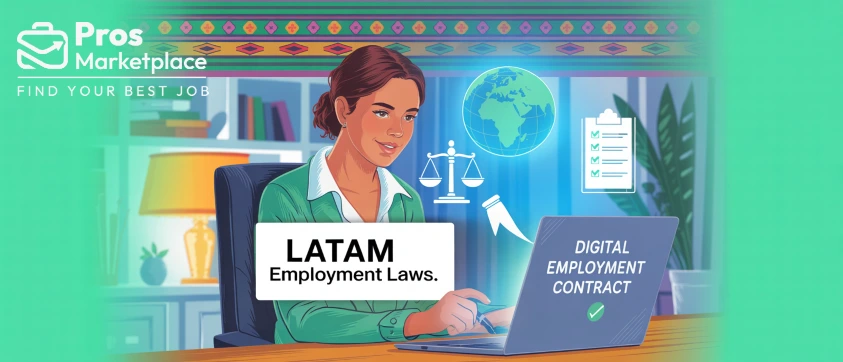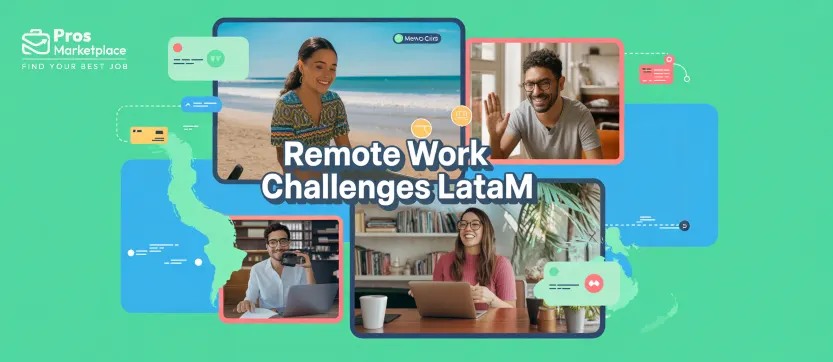Finding the right talent can become tricky as your business scales up.
When the need for qualified professionals increases, the big companies compete for the best. That is why an organization has to adopt a successful hiring strategy that aligns with its long-term goals and the work environment.
The two most common ways of hiring are contract to hire and direct hire. Each has its pros and cons. Understanding the basics of the two will help you understand which one is better for your business requirements.
In this blog, we’ll break down the key differences between contract to hire and direct hire, including what works best and why.
What is Direct Hire?
Direct hiring is a permanent hiring process whereby an employee is hired directly by the company to work full-time. This technique is practiced when the organization requires people who can handle the crucial responsibility of highly critical roles. A long-term commitment is made for both the parties.
Direct hire involves a lot of the company’s investment to find, hire, and engage the right talent. This may even include interviewing the candidate, verifying background, and negotiating salary and other benefits. The employee may be classified as permanent staff from day one and draw all benefits granted by the company.
Direct hire is preferred primarily for stability, especially when companies want long-term solutions for staff needs. Ideally, this is suitable when businesses have certain roles that require certain skills and qualifications for growth in the organization.
What is a Contract to Hire?
With this approach, the candidates are given permanent employment at the end of the contract. This approach allows both parties to find out if they will work well before committing to an extension.
Before making a long-term decision, the candidate and the company must be compatible in terms of efficiency, ethics, and business culture. The employee will have the opportunity to decide if the job fits his niche.
However, if both parties feel that the relationship is no longer necessary, the agreement will be terminated without any long-term consequences.
Contract to Hire vs. Direct Hire Strategies
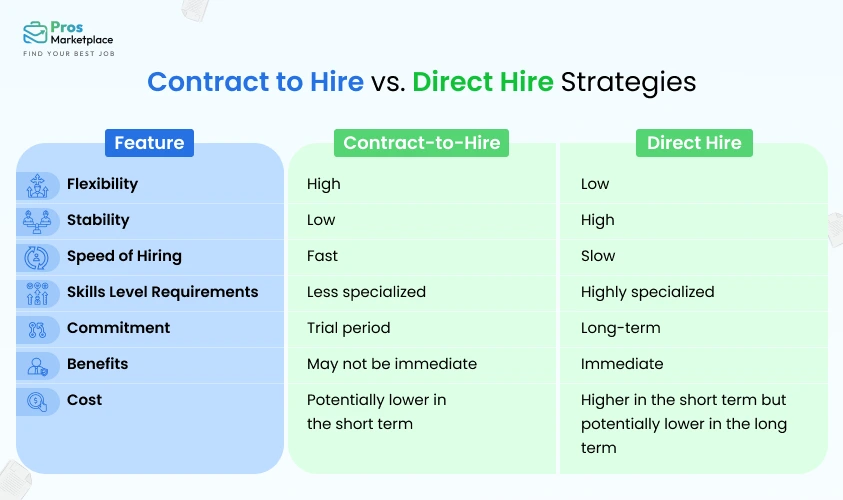
The best hiring strategy for your business can vary, depending on the basic differences between contract to hire and direct hire. Each approach meets unique organizational needs, based on the profile of the position or the type of company, and long-term goals are involved.
Both strategies have unique advantages, and picking the right one may make all the difference for the company’s operational efficiency and its workforce’s stability. Here is what makes them different.
Flexibility vs. Stability
One of the primary differences between contract to hire and direct hiring is the concept of flexibility versus stability. Contract t hire is more suited when businesses are expected to expand or uncertain about their long-term staffing needs. Contract to hire enables businesses to evaluate candidates without having them commit to a full-time position immediately. Flexibility creates the ability to adjust based on project needs or a shift in the market.
On the contrary, direct hire focuses on stability; this is as good as the solution for a firm seeking an individual to occupy a permanent position. A direct hire means a commitment from the first day at work; it is a long-term solution where both the interest of the employer and the interest of the employee lie in a stable relationship.
Speed of Hiring
The other major difference is that the hiring process unfolds at a faster pace with contract to hire. This is because the business needs often come forward as short-term, urgent requests. The hiring process is also simple, with fewer rounds of interviews and faster resolution.
This works very well if a project has to be staffed with more supporting hands quickly or if a business is growing rapidly. On the other hand, direct hiring tends to be a more comprehensive process.
Several rounds of interviews, skill assessments, and lengthy background checks are involved simply because the employer wants to ensure it is the right choice for a long-term position. This being said, although the process takes longer, it tends to end up showing the candidates thoroughly.
Skills Level Requirements
Contract to hire is usually preferred when there is not a highly specialized requirement for the work or it is mainly project-based.
This way, companies can introduce employees who can assist with immediate needs but are not necessarily committing them to long-term professional development. Whereas this role is more suitable for highly specialized skills or positions critical to long-term company success. These employees are expected to grow with the firm over time and contribute to bigger organizational goals. It’s a more extensive and strategic hiring process.
Contract to Hire Benefits
Both contract to hire and direct hire have their benefits. They often complement business models and workforce strategies. So, the one that will work best for you will depend on what your organization needs the most.
The biggest advantage of contract to hire is the trial period. This gives both the employer and the employee the chance to determine whether or not the working relationship would work for the long term without having to immediately commit to a permanent arrangement.
When an employee turns out to be a performer and adjusts to the company culture, he may be offered full-time status. This probationary period reduces the chances of a catastrophic hire, which may not only be costly but also time-consuming. Moreover, cost-effectiveness is yet another important benefit.
Because contract to hire positions are considered first as temporary, companies may avoid some of the responsibilities of permanent workers, such as medical coverage, health insurance, or retirement contributions, when the employee is still under contract.
Such a practice enables companies to increase or decrease the size of their staff based on
the demand for projects at the present moment without tying staff to long-term employment, either in anticipation of uncertainty in the economic environment or experiencing rapid growth.
Finally, contract to hire work almost exclusively involves a quicker process in which new talent can be brought onto the grounds for companies to utilize. Its pace helps organizations deal with a tight time frame in meeting deadlines or filling gaps with resources. Wrapping up, some of the benefits of direct hire are:
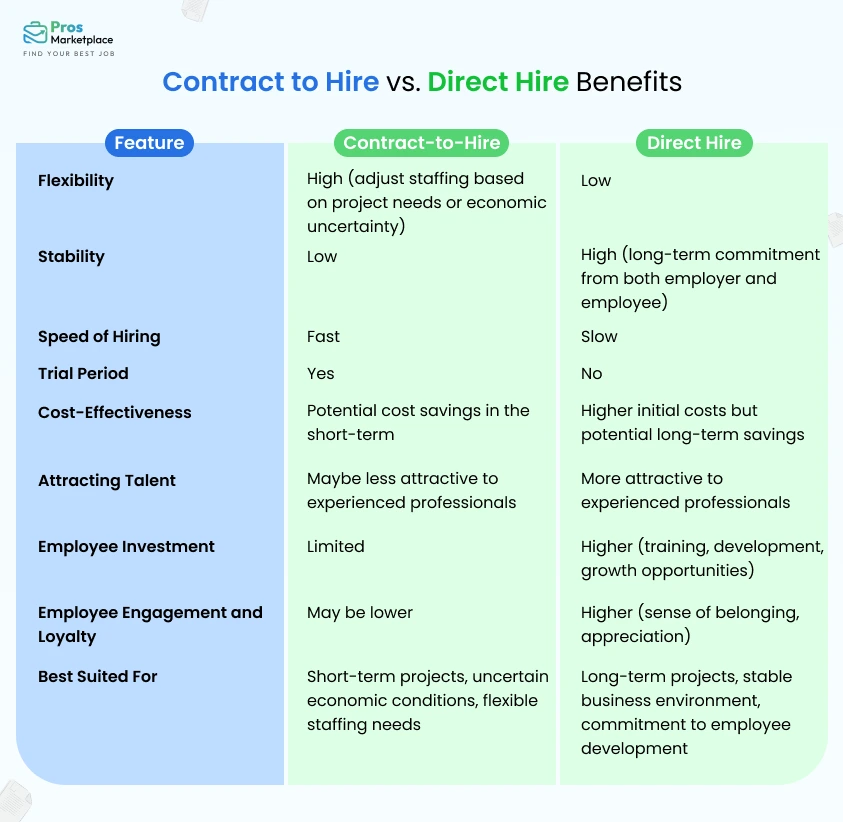
Direct Hire Benefits
Direct hiring has benefits that make it the choice of companies looking for long-term stability and growth. Ideally, one of the most important attributes is that it offers long-term stability. From the first day, an employee becomes part of the functioning of the organization and gets committed to the goals and objectives of the organization.
Such stability gives businesses a solid, committed team that can be put to work on long-term projects and initiatives; turnover and retention are not so high.
Another advantage is that direct hiring attracts the best talent. More experienced or qualified professionals often tend to seek permanent jobs with upward career steps, so the candidate with such experience or skills will prefer a direct hire to a temporary or contract position. The promise of a permanent job with benefits and security is a powerful draw for talent not eager for short-term or contract opportunities.
Last but not least, direct hiring encourages a company to invest in its employees. Since they are termed to be long-term assets, businesses are likely to commit more to the provision of training and development for these professionals.
Thus, it is likely that companies will offer the required kind of training sessions, mentorship, and growth opportunities they need for development. Such a policy leads to higher engagement and productivity because the employees have a sense of belonging and appreciation, and hence, they tend to be loyal to an organization.
Contract to Hire Drawbacks
Both of the recruiting methods are useful, but at the same time, they have some disadvantages that businesses may have to take into consideration. If these possible risks are well-known, companies will make better decisions.
One of the main disadvantages of contracting to hire is uncertainty.
For example, for some candidates, the short-term nature of a contract may not attract them. They may look for job security with the company for many years.
This can severely limit the possible interested candidates because many professionals prefer the security of being a direct hire. It also involves uncertainty for an employer who invests time and other resources in onboarding an employee only to see that person leave permanently.
Another challenge is the lack of loyalty from contract to hire employees. Since these employees are not permanent, they are less frequently engaged in the corporate culture or devoted to the organization’s success like most full-time employees.
Hence, engagement and motivation are reduced, possibly leading to a negative impact on the team’s overall performance.
Also, if a company is going to transition a contract employee into a permanent employee, there may be a transition period. Here the employee must adapt to new compensation structures, benefits, and long-term responsibilities, potentially disrupting productivity.
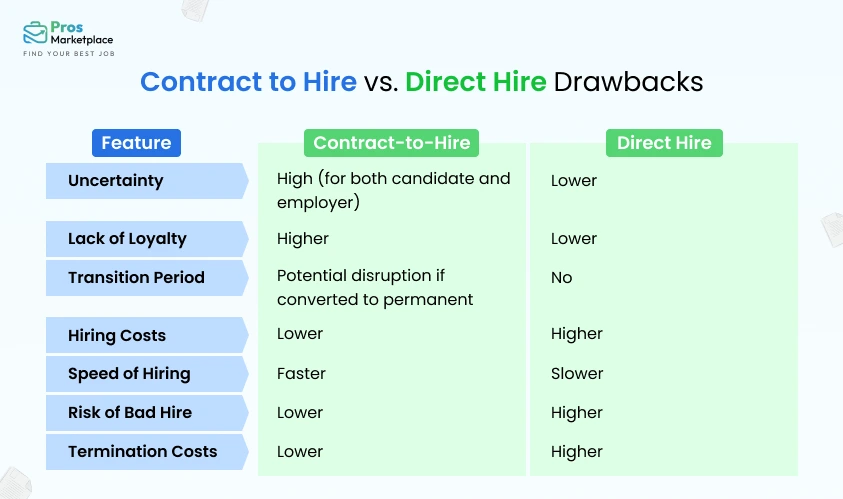
Direct Hire Drawbacks
Direct hiring offers long-term advantages; however, it has its problems as well. For instance, direct hiring costs are higher than the recruitment process itself. Since direct hires require much more investment in terms of the cost of recruitment, cost for training, or onboarding, and all the full benefits from the beginning, this can be an expensive affair, especially for small businesses or start-ups.
For those businesses that require urgent needs or operate with tight deadlines, the longer recruitment process of direct hire is one of the disadvantages of using this method. The strict screening process that constitutes interviews, background checks, and skills and other assessments might be time-consuming to complete before finally hiring someone.
Then, a direct hire brings about the risk of making some bad hires. An extremely strict recruitment process is not guaranteed to prevent hiring someone who will not be able to work to your satisfaction or fit in with the company culture. Termination of a direct hire is costly and may sometimes attract lawsuits, leading to financial loss, especially if such an individual is in a very sensitive position in the organization.
Contract to Hire vs. Direct Hire: Which One is Better?
As per the requirements, businesses may select one over the other; depending on the particular role. If you are focused on flexibility and immediate solutions, contract to hire is a better option. However, for companies that value stability and strength in their teams, direct hire is more effective.
Here, you interview and hire an employee under a fixed-term contract. Evaluate the performance and cultural fit of the employee. When the contract expires you can extend it permanently or separate from the employee.
If your business has a lot of growth potential but is unsure about how many to hire, the contract to hire model will suit you the most. Through contract to hire, short-term goals can be managed without commitment. On the other hand, the choice of direct hiring stands out as appropriate in securing specific types of expertise that call for a long-term commitment from the employee.
Conclusion
Finding the right talent is necessary for any business, especially as it scales up.
Whether contract to hire or direct hire, both have advantages and disadvantages; one is suited for another business need.
Contract to hire is flexible and acts as a testing ground. Thus, it is ideal for temporary jobs or companies that are growing in size. With direct hire, one can be assured of stability, hence the need for businesses seeking to build a team of committed professionals for the long term.
There’s no static strategy in hiring since it depends on your current and long-term needs. Contract to hire may work under certain conditions, while direct hire may work under a specific circumstance. Therefore, understanding these differences will allow you to make informed decisions to strengthen your workforce and take your business to where it needs to be.






